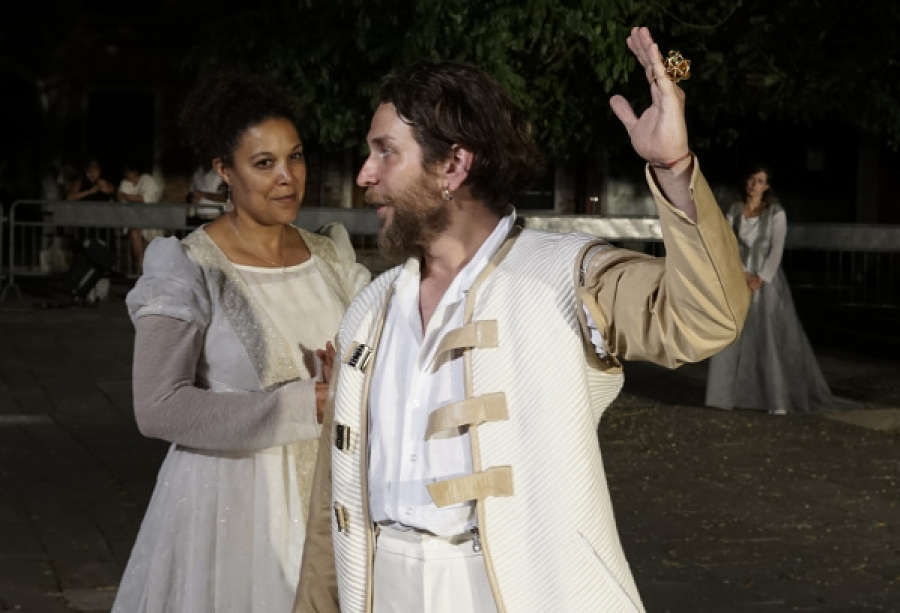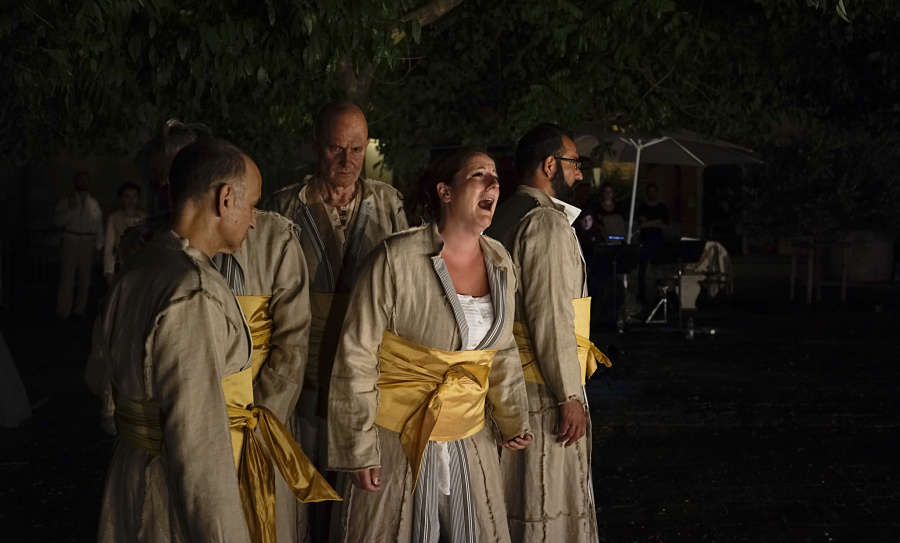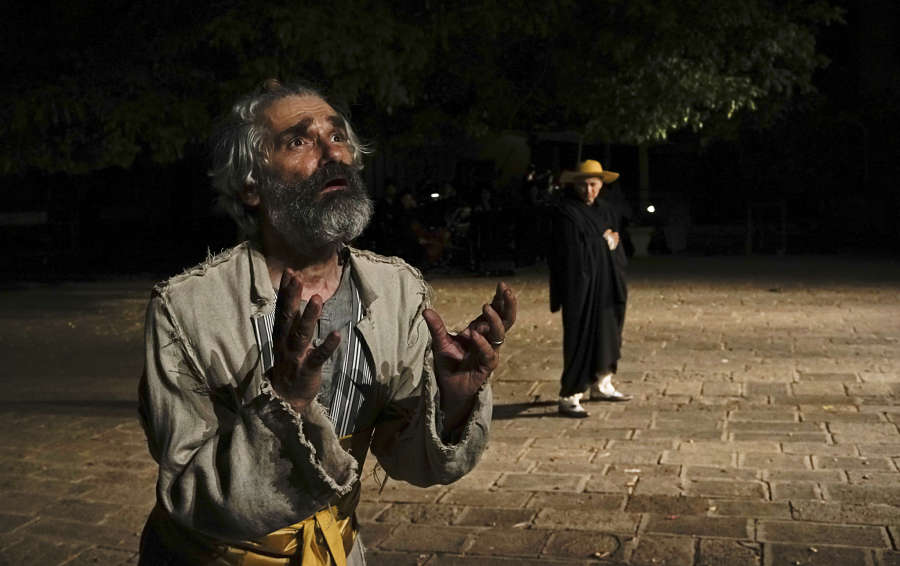Director Karin Coonrod's international staging of The Merchant of Venice makes its North American premiere at New Jesrey's Montclair University, as part of its Peak Performance series, Sept. 19-Oct. 1.
I read and reread the email from David Scott Kastan, a Shakespeare professor and scholar at Yale, inviting me into The Merchant of Venice Project in the Venice Ghetto in 2016. David had imagined an ingenious and provocative way to wrap together the 500th anniversary of the Ghetto’s origin and the 400th of Shakespeare’s death: to perform The Merchant of Venice in the Ghetto itself.
My heart and head pounded with exhilaration and a good measure of trepidation. After all, Merchant is a play freighted with decades of anti-Semitism. The Nazis played it repeatedly to justify their own anti-Jewish killing machines; universities have banned its production; scholars have openly called this play unworthy of its author for its treatment of its larger-than-life character Shylock. And the Ghetto represents both a thriving hub of Jewish world culture and a once-quarantined island, confined and marginalized by the dominant Venetian culture.
I found myself wondering whether a performance in this reborn ghetto of 2016, with its inherent contradiction, might uncover something new in the play and in the culture? Perhaps the exorcising of Shylock’s ghost might send an urgent message that we need to hear now more than ever. How would the neighbors in the Ghetto respond to an American theatre company taking the lead in this production?
The Ghetto is located on a small island in the northeast part of Venice, formally and legally walled off in 1516, just as Venice was at its zenith as a trading and commercial city-state. The informal mayor of the reborn Jewish Ghetto, Shaul Bassi, also a Shakespearean professor at Ca’ Foscari University in Venice and the founder of Beit Venezia, is busy reviving the historic fabric of the Ghetto, its five synagogues and its evocative, all-knowing stone floor, while trying to infuse it and repopulate it with vibrant cultural life, one that embraces all cultures. Kastan and Bassi talked about my directing the play; the mayor was eager for the production not to be imported but rather to be “made in Venice.”
That raised many production considerations: the languages to be spoken for an international audience, the forming of an international company, both on the creative side and among the acting company. It also afforded us a dream open-air venue, the campo—the piazza at the Ghetto center, with its stone floor resonant of all Ghetto life, encircled by historic synagogues, eateries, shops, and modest apartments, complete with three public wells.
At twilight, our curtain time, when the Ghetto’s inhabitants found their perches at balcony or window, we would also find less welcome guests: the chirping cicadas with their incessant mating calls, a backdrop of sexual longing that permeated the Venetian romantic high jinks of Merchant for the first 30 minutes. They stopped every night abruptly at 9:05 p.m.

My theatre company, Compagnia de’ Colombari, had many years of performing in Italy and working with an international ensemble under its belt, and it was partly for this reason that Kastan approached me in the first place. We had performed the medieval mystery plays on Orvieto’s stone streets, and now we were planning to perform on the stone floor of the campo. Peter Ksander, set and light designer, and I talked about the set being “the thing itself.” Peter approached the set with the same unvarnished urban immediacy, designing a stadium seating for the audience and plunking it down in the campo facing the most interesting architecture: the Italian and German synagogues, each with five expressive shuttered windows looking down, as if from behind closed eyelids, on the playing space.
Though Peter and I had much experience together on the island of Manhattan and the cliff town of Orvieto, we never understood until in situ what it meant to build in Venice. The steel traveled from the warehouse to a truck to a canal boat to a hand cart, and finally landed on the campo for construction, all courtesy of our remarkable Venetian technical director, Marciano Rizzo, and his able crew.
Several knowledgeable Venetians pointed me to Stefano Nicolao, who has a well-appointed atelier just minutes away from the Ghetto on the Fondamenta Misericordia (next to some delectable eating places). He became the Merchant costume designer. Stefano responded to my aesthetic by pushing past the heavy period costumes and designing with a fluid elegance that honored the Elizabethan silhouette with a very light modern touch. I wanted this ease in the clothing, since costume changes would be as open-air as the play, and would be woven into the performance itself.
At the invitation of Shaul Bassi and Venice’s Ca’ Foscari University, Beit Venezia, and Fondazione Cini, we took “The Shylock Project” (as we called it) into workshop on Isola San Giorgio in the summer of 2015. There I developed my approach to The Merchant of Venice. From the U.S. I brought two actors and two dramaturgs, and from Brussels, my directing assistant; in Venice we found a lively group of 15 Venetian performers. Over 12 intense days, the workshop gave me my first opportunity to sketch out the theatrical approach to Merchant.

We developed the play mostly in English with two scenes in Veneziano Italian. In lively preparatory conversations with dramaturg Walter Valeri, we chose an oration by Ruzzante “on love” to be spoken by Launcelot—or Lancillotto, as we called him—in the prologue, hence starting off the “comedy” on the scent of sexual love. We freely used Italian throughout, with bits of Spanish (for the Prince of Arragon) and bits of Arabic (for the Prince of Morocco), passages in French and German in the mockery of Shylock, and heightened moments for each Shylock scene in Ladino, Judeo-Venetian, and Yiddish.
In popular memory the play hangs on two famous speeches: Shylock’s plea for humanity (“Do we not bleed?”) and Portia’s argument for mercy (“The quality mercy is not strained”). The character of Shylock himself has become iconic over centuries in thematic portrayal, from clown-villain to tragic hero. And Portia is often characterized as a smart, good-natured heroine.
Yet the play seems to dig deeper into the dark heart of humankind beneath these two uncompromising poles of justice and mercy; Shakespeare turns us to the mirror and opens the soul of our humanity. For any director the challenge is to tear the play out of the expected, to revive its vital, beating heart, to uncover what we must know now.
I had considered the possibility of a famous actor to play the role of Shylock. Certainly there have been many memorable performances of Shylock across the boards and on the screen. Was there a 21st-century wavelength that would allow this ancient man, this cantor of humanity, to tell us something? But rather than concentrating the dimensions of Shylock on one actor’s interpretation, I went a different direction, and one consistent with my ensemble company: opening up the character to five actors of different age, size, race, and gender, each actor playing one of Shylock’s five scenes.
The point was not to ignore Shylock’s Jewishness, nor to divide his complex character, but to unlock and unveil the common humanity of his being. Shylock the Jew is also Shylock the immigrant, the Other, the stranger. True, a five-actor Shylock would demand more of its audience; but my hope was that the audience would find itself in Shylock. Of course Shylock cannot be painted with a single brushstroke: The play takes us through his keen mind, his belief, his love, his sorrow, and his murderous rage.
In the Venice workshop we tested this idea. Five actors played five very different aspects of Shylock: the businessman, the father, the mother, the widower, and the killer. In the third scene of the play we meet Shylock for the first time. We looked carefully at this scene, when Shylock #1 (played by Sorab Wadia) spars with Antonio (played by Reg E. Cathey in workshop and by Stefano Scherini in production). In the fierce negotiation between these two cynical businessmen of the infamous bond, each is a reflection of the other. Both are rivals and players in a high-stakes world, one a Venetian citizen, and the other marked as a resident of the Venice Ghetto, both well versed in the commercial law of Venice, both inside this snarling recognition of the Other at the moment that they make the deal, a mutual refusal to break the wall of pride which foretells the play’s tragic climax.
The ugly history of tribal enmity that shadows that first Shylock scene is surely one we recognize. Shylock knows this man well, and hates this Venetian of the dominant class, as a “Christian” who “rails” on him and his “well worn thrift.” Antonio, embarrassed by his need to go to a social inferior for an exorbitant loan, responds by bullying, “Well, Shylock, shall we be beholding to you?” Shylock sarcastically responds, “Is it possible a cur can lend three thousand ducats?” and “Fair sir, you spat on me on Wednesday last.” An odd intimacy infuses their mutual hostility—a Machiavellian respect for the enemy with whom you must ultimately reconcile so that business can resume and life can go on.
Both actors are locked in a laser beam of anger, broken only when Shylock suggests the infamous pound of flesh, the “merry sport” which forms the basis of the bond. Antonio slowly begins a deep, cackling sound which ignites Shylock to join him. Are they old friends or old enemies? The idea is so ludicrous and transgressive and of a sudden, like a locker-room bet. Both at this point have no doubt that Antonio’s ships will come in to harbor, as they always do, and that the bond will be paid with cash, not flesh.
Long before the famous court scene and Shylock’s demand for his pound of flesh, and the cruel manipulation of justice which follows, Shakespeare has provided the play’s thematic set-up: Antonio’s un-Christian excoriating of the stranger, Shylock’s hatred of his sworn enemy, the cool machinations of Venice’s celebrated commercialism, the reduction of human promise to a written bond, with inhuman consequences. Even the love story of Bassanio (played by Michele Guidi, from Italy) and Portia (played by Linda Powell, U.S.) is hardly romantic. Cold mercantilism infuses all the transactions in Merchant: the enmity of borrower and debtor, of course, but also the play’s parallel theme of love and marriage, the manipulative dance of the wealthy Portia and the needy aristocrat, Bassanio.

As I understood this play and developed the inner architecture of the production’s themes, two “crescendos” emerged, wherein the five Shylock actors would come together, unified by the gold sashes which adorned them. In the third Shylock scene comes that first crescendo, at the very instant of Shylock’s desperate moment of the heart, when he discovers his daughter has left him and run away with the Christians. We watch as the humiliations of the marketplace and Venetian citizenship cast upon Shylock devolve into an even more crushing excoriation of family, of tradition, of the spiritual center of Jewish life.
Daughter Jessica (played by Michelle Uranowitz, U.S.) is drawn into an escape away from the protective, rule-bound hands of her father by the irresponsible and greedy Lorenzo (played by Paul Spera, France) and his fellows. On its surface we understand the prodigal nature of her revolt: It is a hormone-driven teenage rebellion. Yet the intention of the Christian plotters is to humiliate Shylock—to steal away that which is most dear to him. Her escape is the unhinging of the play. Jessica flees with Lorenzo and his pals into the carnival night, laughing giddily, with masks, torch, and suitcases of Shylock’s money.
This unhinging of the play is what I imagined as the first crescendo. At the call of a haunting trumpet (played by composer Frank London) wafting from the rooftop, the five actors playing Shylock emerge for the first time together, forming a huge circle in the Ghetto’s playing space. (Each actor also plays another role.) They are ritualistically dressed by the “black angels” (our visible performing crew) with cloak and thick golden silk sash wound around their torsos to mark them as the Jew. The Venetians circle around the five Shylocks, hurling ethnic epithets, demeaning, vulgar and vicious, in the same spirit as that of Antonio earlier (these lines are all taken from the scenes between Salanio and Salarino).
The third Shylock scene emerges from this circle of five, as he discovers what we all have seen: that his daughter has deserted him into the hands of the Christians. The third Shylock is played by a woman (Jenni Lea Jones, from the U.K.), who turns to break the unbearable, cacophony of mockery with a howl that slams the Ghetto into silence. As one audience member remarked of this moment, Jenni’s lung-filled, mournful cry reached something deeper than pain, becoming a cure for the Ghetto, a soulful healing. The gathering of all five Shylocks knit together the cross-human DNA of loss, rejection, the quest for dignity, cultural continuity, the root of personal existence. Jones’s howl was also a kind of prologue to Shylock’s rhetorical questions, beginning with, “Hath not a Jew eyes?”
Crescendo number two, the second gathering of the five Shylocks, came at the close of the play, after the blood-curdling confrontation in the courtroom. In the courtroom setting, Shylock #5 (played by Ned Eisenberg, U.S.) enters the scene in certitude demanding strict enforcement for the pound of Antonio’s flesh that belongs to him: “I will have my bond.” What had been agreed upon “in merry sport” now becomes deadly with the loan past due. For the first time in Merchant we hear the word “mercy.” In the trial scene the presiding Duke (played by Jones) calls for it, and then again Portia (Powell), disguised as a male judge, enters the trial with her wise argument for it.
Underlying her argument is her manipulation of the power of the state and Shylock’s impotence before it, as a member of the outcast tribe. Ned and I spoke about how Shylock listens to Portia’s poetic and manipulative argument, in which she appropriates mercy as a Christian virtue, ignoring that it’s a central tenet of Judaism. As the Hebrew prophet Micah put it: “He hath showed thee, oh man, what is good; and what doth the Lord require of thee, but to do justice, to love mercy, and to walk humbly with thy God?” In the world of the play, a mercy never expressed for the Jew in the street is conveniently required of the Jew in the court. How must Shylock be listening to this specious argument? It reeks of dissembling. What is ultimately cast upon Shylock—by a law that is not judicial, not humane, but rooted in power and expressed in cruelty—requires that he give up his wealth, his family, and his faith.
That’s where Shakespeare leaves Shylock—and us. In the text Shylock does not reappear. The final scene is all restoration of lost rings and financial gifts, the interplay of women’s wiles and men’s coarse assumptions. I am certainly not the first director to puzzle over Shakespeare’s conclusion, comedic for his day, perhaps, and with a bittersweet taste, but unsatisfying. I saw Shakespeare’s gathering of the privileged ruling Venetians in Belmont as a setting for a reprise, where the five Shylocks could enter—one at a time—and take to task the ruling culture by repeating Shylock’s words spoken at the beginning of the trial scene, as guardian of his dignity, his personhood, in contravention of the gleeful winners, and finally, as a mirror to the audience:
You’ll ask me why I rather choose to have
A weight of carrion flesh than to receive
Three thousand ducats. I’ll not answer that
Referencing animals used as insults against him, Shylock insists on his prerogative, his free will, as a human. Then, as the play concludes, he asks the audience: “Are you answered?”
The final moment in the Ghetto performance, however, deals with the mercy left unactivated in the play by the humans. On the Ghetto walls, which had silently witnessed so much over the centuries, were projected the words “Mercy, Misericordia, Rakhamim”—to bring back in this final moment a word, a concept, so eloquently spoken of but so categorically abandoned.
The problems of justice and mercy, of indebtedness between rich and poor, between those in power and those marginalized outsiders, were brought centerstage all the more clearly and poignantly in two performances that followed immediately upon those in the Ghetto. We performed at the Summer Theater Festival in Bassano del Grappa, playing to a house of privileged, free-spirited midsummer theatregoers, and the next day to the marginalized inmates of the Padova Prison, a high-security men’s prison. In both cases the attention shown to the performances demonstrated that this Merchant, relaunched from the Ghetto’s stones, is a play for our own time.
Now, as we eagerly prepare its next incarnation, a North American premiere at Peak Performances in Montclair, N.J. (Sept. 19-Oct. 1), it may reasonably be asked: Will this Merchant speak to contemporary U.S. audiences as it did to Europeans? It’s a play in which money and celebrity are valued above all by the dominant culture, adn in which a marginalized Other is framed to expose the mendacity of the controlling system.
Are you answered?


